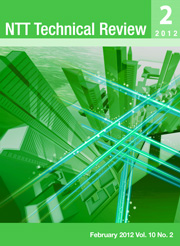
You need Adobe Reader 7.0 or later in order to read PDF files on this site.
If Adobe Reader is not installed on your computer, click the button below and go to the download site.

|
February 2012 Vol. 10 No. 2 |
|

Feature Articles: Imaging and Sensing Technologies for Safety and Security
 NTT R&D of Systems and Devices for Safety NTT R&D of Systems and Devices for Safety

Abstract
In this article, we introduce NTT's research and development (R&D) of imaging and sensing technology for making the hidden visible in order to make our lives safe.
 Millimeter-wave Imaging for Detecting Surface Cracks on Concrete Pole Covered with Bill-posting Prevention Sheet Millimeter-wave Imaging for Detecting Surface Cracks on Concrete Pole Covered with Bill-posting Prevention Sheet

Abstract
In this article, we introduce millimeter-wave imaging technology for detecting submillimeter-wide cracks under a bill-posting prevention sheet on a concrete telegraph pole.
 Detection of Cracks in Concrete Structures from Digital Camera Images Detection of Cracks in Concrete Structures from Digital Camera Images

Abstract
In this article, we introduce an image processing technique for detecting fine cracks in concrete poles by examining remotely acquired photographs
 Remote Detection of Hazardous Gases in Full-scale Simulated Fire by using Terahertz Electromagnetic Waves Remote Detection of Hazardous Gases in Full-scale Simulated Fire by using Terahertz Electromagnetic Waves

Abstract
This article describes a prototype spectroscopic sensing system that we have developed for detecting hazardous gases at the scene of a fire from a distance. First, the system's terahertz signal generator and receiver are briefly described. Then, sub-terahertz-band absorption spectra of smoke generated from heated nylon fabric are explained. Finally, a performance test of the developed sensing system carried out in a full-scale simulated fire is presented.
 Development of Terahertz-wave Photomixer Module Using a Uni-traveling-carrier Photodiode Development of Terahertz-wave Photomixer Module Using a Uni-traveling-carrier Photodiode

Abstract
As a promising power source for various terahertz-wave (THz-wave) applications, we have developed a compact, lightweight, high-power, and ultrawideband THz-wave photomixer module using a uni-traveling-carrier photodiode. The module operates at room temperature and exhibits output power of over 0.5 mW at 0.35 THz and a 10-dB-down bandwidth of 260 GHz. Its output frequency can be swept continuously over an extremely wide frequency range in the terahertz band. In this article, we report on the photomixing technique using an ultrahigh-speed, high-power photodiode to generate THz-waves and the development of two versions of the photomixer module.
 Visualization of Pharmaceutical Drug Molecules by Terahertz Chemical Imaging Visualization of Pharmaceutical Drug Molecules by Terahertz Chemical Imaging

Abstract
Terahertz spectroscopy allows the detection and identification of various molecular networks of chemical bond interactions, including those of hydrogen bonds. In this article, we explain terahertz time-domain spectroscopy, the principles of terahertz chemical imaging, and a multicomponent quantitative analysis method for amino acids that can visualize pharmaceutical crystalline polymorphs as an example of this technology.
 Portable Sensor for Determining Benzene Concentration from Airborne/liquid Samples with High Accuracy Portable Sensor for Determining Benzene Concentration from Airborne/liquid Samples with High Accuracy

Abstract
Our previously developed portable monitoring system for detecting airborne benzene down to the level of one part per billion (1 ppb) has been extended to a portable sensor for liquid samples through the development of modules for extraction from the liquid phase to the vapor phase based on two protocols: bubbling and pervaporation. This portable sensor has demonstrated a high selectivity to benzene or a detection limit below the one-part-per-billion-by-volume (1-ppbV) level depending on the extraction protocol.
Regular Article
 Acoustically Controlled Spin Precession Revealed by Two-dimensional Imaging of Spin Transport in GaAs Acoustically Controlled Spin Precession Revealed by Two-dimensional Imaging of Spin Transport in GaAs

Abstract
Magneto-optic Kerr microscopy was used to investigate the spin precession of electrons traveling in semiconductor quantum wells by using surface acoustic waves (SAWs). Two-dimensional images of the SAW-induced spin flow reveal anisotropic spin precession behavior caused by the coexistence of different types of spin-orbit interactions. The dependence of spin-orbit effective magnetic fields on SAW intensity indicates the existence of acoustically controllable spin-orbit interactions resulting from SAW-induced strain and SAW-induced Rashba contributions. These phenomena will provide the versatility needed for spin manipulation in future spintronic applications such as spin transistors and quantum computers.
Practical Field Information about Telecommunication Technologies
 Damage to Plastic Components Caused by Solvent Cracking Damage to Plastic Components Caused by Solvent Cracking

Abstract
This article introduces two case studies of damage to plastic components caused by solvent cracking and the countermeasures developed by NTT EAST. It is the ninth in a bimonthly series on the theme of practical field information about telecommunication technologies. This month's contribution is from the Materials Engineering Group, Technical Assistance and Support Center, Maintenance and Service Operations Department, Network Business Headquarters.
Information
External Awards
|
